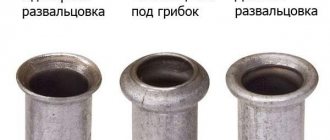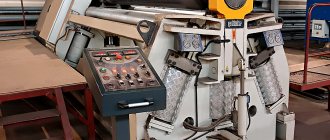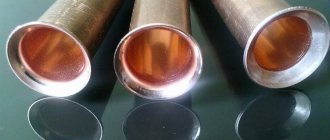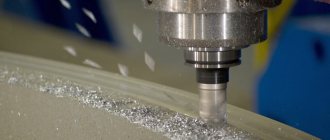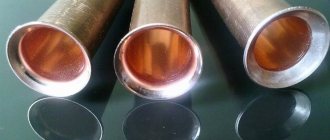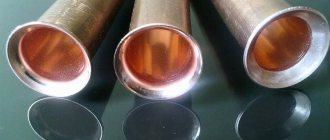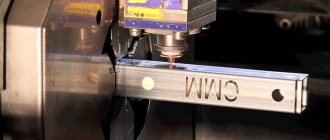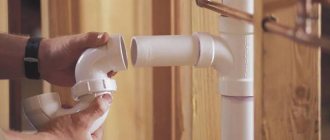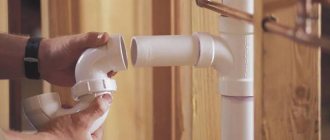Pipe rolling is a necessary part of the process of partially changing the shape of pipes, due to which hollow metal products are given the required configuration or the diameter is expanded. Pipes can be rolled in different directions, depending on the intended result. The process of changing the diameter is carried out on machines in the workshop or at home - using simple devices. Using the rolling method, it is also possible to form products from sheet metal.
To change the original shape of the pipe, a rolling operation is used
Features of the rolling process
Rolling is an affordable process for manufacturing all kinds of metal parts or pipe sections of the required format. Each tube flaring tool has its own specifics, but this process is also used for other purposes - processing a metal rod or thin sheet metal.
The name of the process comes from a primitive device - special rollers are quite simple in design and operation, but they provide a wide rounding radius for the workpieces. Industrial production involves the use of forging rollers (rolls) through which a piece of metal passes.
Correct use of the tool guarantees high-quality and uniform deformation along a given circle or at a certain angle. For example, you can get a blank of the correct cylindrical shape or a curl for a forged gate using rollers for a profile pipe with your own hands.
Rollers are selected according to the thickness of the metal product; rollers with a large radius are often required. Not only steel becomes ductile when processed with the above devices. Plastics, polymeric materials and some rods, sheets and metals are deformed in a similar way:
- aluminum;
- black metal;
- soft alloys;
- galvanization.
Rolling is also called rolling a pipe on a special machine in order to obtain a bent workpiece
Attention! Today, pipe bending and rolling is a common service, but you can master this process yourself if you have an easy-to-use device. Such skills are applicable in various folk fields and industrial production, in the manufacture of welded structures - stairs, gates, furniture.
The most common methods of forming metal products after rolling a profile pipe:
- stretching;
- bending;
- winding;
- flaring of holes.
The process involves securing the pipe into the lumen using expansion, and the diameter of the pipe must be smaller than the opening. To ensure reliable connection, rolling equipment is used. But this concept implies different processes:
- Rolling as a method of changing the width of the inlet hole, lumen or diameter of the pipe during heat treatment and welding.
- Rolling of pipe bends.
- Rolling as a method of reducing diameter.
- Rolling a section of seamless pipeline.
- Flaring the workpiece to change the diameter of the pipe (increase).
Attention! Without experience, pipe rolling is not an easy task, and with excessive force, the metal will lose its ductility and may crack, and other signs of destruction will appear.
This is interesting: Chrome plating - decorative coating of metal with chromium: technology, types
Rolling of aluminum pipes - Metalworker's Guide
Specialists often have to change both the configuration and other geometric parameters of pipe rolling to solve various problems.
Most often, to change the shape and size of a tubular product, a technological operation such as flaring is used.
It should be borne in mind that this operation is fundamentally different from what is called rolling, and these differences are significant.
The ends of these copper pipes are flared: expanded to a specific shape and prepared for connection
How to roll pipes - options and methods
What is the rolling process
Production of pipe products
Flaring process
Rolling
Profiling of pipe products
Pipe benders
Pipe rolling or rolling is usually called a process, the result of which is the deformation of metal products in different directions. Using this action, a material such as metal is bent. In industrial settings, rolling is usually carried out using forging rollers.
Cost of services
| Sheet thickness | D=500 rub. VAT included | D=1000 rub. VAT included | D=1500 rub. with ND | D=2000 rub. VAT included | D=2500 rub. VAT included | D=3000 rub. VAT included |
| 4 mm | 3 325,00 | 5 500,00 | 8 200,00 | 10 450,00 | 13 437,50 | 15 850,00 |
| 5 mm | 3 914,00 | 6 640,00 | 10 024,00 | 13 844,00 | 15 274,00 | 20 612,00 |
| 6 mm | 3 903,00 | 8 780,00 | 12 816,00 | 15 238,00 | 19 110,50 | 24 308,00 |
| 8 mm | 6 650,00 | 11 000,00 | 16 432,00 | 30 900,00 | 25 844,50 | 33 766,00 |
| 10 mm | 6 828,00 | 12 280,00 | 20 048,00 | 25 688,00 | 30 548,00 | 39 224,00 |
| 12 mm | 8 006,00 | 13 560,00 | 21 664,00 | 28 476,00 | 34 251,50 | 44 682,00 |
| 14 mm | 9 153,00 | 15 780,00 | 25 280,00 | 33 138,00 | 39 955,00 | 52 140,00 |
| 16 mm | 10 331,00 | 18 060,00 | 28 896,00 | 37 926,00 | 45 658,50 | 59 598,00 |
| 20 mm | 13 656,00 | 22 560,00 | 36 160,00 | 47 376,00 | 57 096,00 | 74 580,00 |
| 25 mm | 15 601,00 | 28 260,00 | 45 184,00 | 59 346,00 | 71 370,00 | 93 192,00 |
| 30 mm | 18 515,00 | 33 900,00 | 54 208,00 | 71 190,00 | 85 644,00 | 111 804,00 |
| 35 mm | 25 343,00 | 45 120,00 | 72 288,00 | 94 752,00 | 114 192,00 | 149 094,00 |
Pipe rolling tool.
Rice . 3 . Lid rolling (self-feeding):
1 - spindle (rod); 2 - cover; 3— rollers.
Self-feeding rollers are sometimes incorrectly called impact rollers. Self-feeding rollers have some skew of the windows for the rollers (skew in relation to the body).
A hand-rolled cone is rotated by a regular crank placed on the square of the cone head.
The main features of various types of rolling bodies are the presence of a thrust plane or a special thrust ring, as well as the method of making windows for the rollers and their bracing.
The purpose of the thrust plane is to make it possible to correctly install the rolling (screw rolling) or to limit the translational movement of the rolling body during the rolling process (self-feeding rolling).
Rolling bodies are made with a cover (Fig. 3.) which is a stop with a movable installation thrust ring.
If we compare some designs of rolling machines, it can be noted that the thrust plane will work correctly only if it receives the necessary stop in the tube sheet. It is important to note that all protruding ends of the rolled pipe must be cut to the same height.
Pipe rolling video.
Currently, automatic rolling using a machine is used. This method significantly reduces rolling time and labor intensity, and as a result, productivity increases. Rolling using a machine drive has the following advantages:
a) the rate of pipe expansion per revolution of the rolling body is not limited by any limits;
b) the end of the flaring is determined automatically by the flaring limiter, based on the magnitude of the force on the flaring cone;
c) the rolling process proceeds evenly and smoothly.
You can see an example of such rolling in the video below.
Tools
If you are interested in how to flare a copper tube at home, then you need to acquire the necessary equipment to complete the task. The melting tool consists of several rollers that are rolled along the inside of the workpiece. Each time they deform it more and more.
- Pipe ruptures are not possible . The machine operates in such a way that the rollers barely process the tube per pass. The product tolerates gradual deformation well, without the possibility of rupture at the point of pressure.
- Smoothness of the tube surface . If you use a high-quality machine, then no tears, burrs or other defects will form on the workpiece. Steel wheels are constantly rolling along tram rails. That's why they look perfectly smooth. The same thing happens with pipes after high-quality flaring (read: “Methods of flaring copper tubes and the necessary tools”).
- The wall thickness of the workpiece becomes the same . Thicker areas will be rolled to the same thickness. Therefore, the pipe will eventually become smoother, even if it initially had a small defect, for example, inhomogeneity.
There is also a method of rolling with a cone. This option is used to reduce the cost of the process. In this case, the cone is pressed into the fixed pipe. In this case, the quality of work will be lower, but in some situations it will be sufficient. Read also: “How pipe rolling is performed - options and methods.”
In general, hand-rolling tools are not equipped with an electric motor. It is most often used in stationary fixtures connected to a pipe bender.
Flaring of copper products is distinguished by its simplicity. After all, this material is quite plastic. Therefore, the work is completed without much effort. What cannot be said about flaring aluminum pipes. They will require more effort.
The cost of rolling machines varies greatly. It all depends on the configuration, manufacturer, quality and operating principle. If you want to purchase a tool from a reliable manufacturer, then you should pay attention to the brands GEDORE, BETA, BRITOOL and other well-known brands. But they are expensive machines. Purchasing a professional tool makes sense if you plan to use it constantly or make money from it.
Read also: How to connect a three-phase motor to one phase
When you need a one-time use of a copper pipe roller, you can buy a model from the middle price segment. It will be enough to install water supply in the house. There is no point in buying a very cheap machine, because the risk of its rapid breakdown is high.
Rolling is necessary for a strong connection of pipes with a tube sheet or other structures. It is able to withstand loads arising from pressure and gravity.
The operating principle of rolling.
The operating principle of rolling is as follows. Three hardened steel rollers are enclosed in one common cage, between which there is a conical spindle. The rotation of the spindle causes rotation of the rollers, which roll along the inner surface of the pipe. Gradually increasing the distance between the rollers with the conical part of the spindle, they apply pressure to the walls of the pipe and expand them, or, as they say, flare them.
Using the spindle cone, the distance between the rollers is increased or decreased manually using a pressure nut or automatically.
The axial pressure of the spindle on the rollers turns into radial pressure of the rollers on the pipe walls. Under the pressure of the rollers, the pipe first expands until it comes into contact with the walls of the hole, and then the pressure is transferred to the walls of the hole. The metal is rough and the tube sheet becomes deformed.
The walls of the grid opening prevent further increase in the outer diameter of the pipe. Therefore, the internal diameter of the pipe can continue to increase only by reducing the thickness of the pipe walls. The metal is said to “flow” and fill all the gaps between the surfaces of the walls of the hole and the pipe, providing the necessary tightness of the connection.
The radial pressure of the rolling rollers is largely absorbed by the pipe walls, so the body of the hole wall receives only elastic deformation and, after removing the rolling, tends to return to its original position, thereby providing the necessary strength of the connection.
The reliability of a rolling connection depends on a number of factors:
- on the number of rollers in the rolling;
— on the flaring diameter;
- on the size of the gap between the walls of the hole and the pipe;
- on the condition of the surfaces of the hole wall and pipe;
— on the speed at which rolling occurs;
- depending on the rolling method.
The absence of annular cracks in the pipe flaring areas confirms the correctness of the process.
Conventional rolling consists of a cone with a thrust ring, rollers, a pressure sleeve and a spindle.
Basically, the number of rollers in rolling is from 3 to 5.
Depending on the operation being performed, rolling rollers or, together, rolling and flanging rollers are installed in the rolling body. The bead rollers are arranged “spaced apart” (Fig. 1, a), or “in single file” one after another (Fig. 1, b).
Rice . 1. Position of rollers in rolling.
The arrangement of the rollers spaced is more expedient than the arrangement in single file, because with this arrangement there is no deformation of the inner surface of the pipe at the junction of the rolling and bead rollers. And also, the mutual overlap of the rolling and bead rollers makes it possible for the bead rollers to enter the pipe smoothly during forward rolling movements.
Types of rolling.
Rolling machines are divided according to the method of feeding the cone (spindle) into screw and self-feeding, and according to the method of rotation of the cone (spindle) into manual and mechanical.
Screw rolling (Fig. 2) has an installation ring with a stop in the tube sheet, so it is easily installed in the correct position, regardless of the length of the protruding ends of the pipes and regardless of the operation of securing the pipes. The design of screw rolling is more complex than other rolling methods.
Rice . 2. Screw rolling:
1 - frame; 2 - roller; 3 - thrust ring; 4 — pressure sleeve with thread; 5 - spindle.
In screw rolling, the cone is fed by a pressure sleeve as the pressure of the rollers on the pipe wall is released. Thus, screw rolling is characterized by variable roller pressure. For mass manual rolling of pipes, it is not recommended to use screw rolling, since the time required to tighten the feed cone screw and the time required to flare one end of the pipe is significantly greater than for self-feeding rolling (Fig. 3).
Pipe flaring kit
The choice of tools for making more copper products is very wide. It may include the following combinations: • Mechanical flaring machine.
• Electric flaring machine.
• Set for rolling copper tubes, which also has expanders, pipe cutters and wrenches for work.
It is better to buy such a set when you are going to constantly perform such installation work, for example, for your own income. And if you only need to perform expansion once, then the simplest set for universal work, which contains a regular flaring machine, is also suitable.
Flaring stages
To obtain a reliable connection for a pipeline made of copper tubes, it is necessary to correctly roll the structure. And if you decide to flare the pipes yourself, then you need to follow these steps to do everything correctly: 1. First you need to clean the end of the pipe. 2. Then you put a specially selected coupling on the stripped part. 3. The pipe must be inserted into the flaring machine, then rotate it until a small edge of forty-five degrees is obtained. 4. Then carefully remove the completed product. 5. And use a coupling to secure two sections of the ends of the pipe. Of course, not only such fittings can be connecting parts. With the help of a professional flaring machine, you can prepare pipes for soldering fastening. The methods are basically similar. They involve deliberate deformation of the pipe to a certain size.
Why is flaring necessary?
Today there is a very large selection of different types of copper pipes, as well as the elements that are necessary to connect them. Therefore, you can easily select the desired profile or fittings. But there are times when rolling a tube with your own hands is simply necessary. It cannot be replaced if: • Equipment of the required shape is not produced in production. • Fittings are commercially available, but are not currently available for purchase. • The product must be precisely adjusted.
Rolling tools
Of course, to properly flare a pipe with your own hands, you need to have a special tool. But simple equipment can be made from materials. This is a template shaped like a cone; it is inserted into the tube and it is turned until the desired result is obtained.
Devices for flaring copper pipes
Such equipment has its disadvantages: • It is impossible to control the accuracy of the fit. • The walls of copper tubes may change their shape. Therefore, rolling yourself is not a reliable way to carry out the processing. It can be used rarely, for example, in one specific case. Since it is still not entirely applicable for fastening in the water supply system, installing air conditioning or refrigeration units.
We recommend: Non-ferrous metal products: types and applications
Scheme of correct pipe flaring
And to get the job done right, you need to find more reliable tools. At home, rolling in the form of a cone is suitable for use. It is equipped with clamps in order to put on copper tubes of any size. But the result obtained is not entirely good. A special set for rolling tubes includes equipment with a safety ratchet. And the most important tool included in this set is the flaring tool. It is specifically designed to work with copper tubing.
Specific terminology of different rolling methods
The concept of “pipe rolling” is a bit of a misnomer from a linguistic point of view. This term implies two opposite operations, and parts of the deformation of the workpieces are performed without rollers.
Summarizing the terminology, it is worth mentioning that rolling is:
- changing the shape of the pipe (turning into a round, square, oval shape);
- bending at an angle or along a radius;
- molding a round or flat blank into a tube-shaped product;
- end expansion or enlargement of one end of the pipe in order to prepare for joining with a part or fragment of the pipeline;
- crimping the end of the pipe end to create a hermetically sealed joint (reducing the diameter);
- cutting metal to give the end of the pipe a different shape and diameter.
Privaltsovka. The expansion process begins after the pipe is inserted into the forming hole. This eliminates the gap between the edges of the hole and the pipe bender. Next, you need to apply force to start the deformation process with a tighter joint.
Hand tools are used to flare soft metal pipes
Flaring of steel pipes is the most common method of deforming pipelines and other products. This is a method of expanding the diameter of one of the pipeline fragments - for high-quality articulation of the sections. After such processing, the communication sections are joined using a telescopic method - the end of one pipe fits as tightly as possible into the next fragment.
Flaring of copper pipes is often used when installing water pipes and air conditioning systems. This operation (as for all other metal pipes) is performed with the following equipment:
- clamp (expander);
- ratchet (adjusts pressing force);
- cone or funnel (changes the diameter to a larger value).
Attention! Cone-shaped equipment is used for malleable and ductile metals.
Rolling is the reverse process of flaring, reducing the inlet opening of the pipeline. Often, simple devices such as a vice and a hammer are used to narrow the diameter. Also, the edges can be given a different shape - like profiled pipes. This method also eliminates defects on the edges of the tubes that occurred during cutting.
This is interesting: Shewing - processing of gears: equipment, nuances of the process
How to roll pipes - options and methods
What is the rolling process
Production of pipe products
Flaring process
Rolling
Profiling of pipe products
Pipe benders
Pipe rolling or rolling is usually called a process, the result of which is the deformation of metal products in different directions. Using this action, a material such as metal is bent. In industrial settings, rolling is usually carried out using forging rollers.
What is the rolling process
To understand what pipe rolling is, you should familiarize yourself with all the operations performed with pipe products that involve the use of this technology:
- Blanks that have a round or flat shape are turned into products called pipes.
- The diameter of the end of the tube is increased in order to make a connection between it and another part or section of the line.
- The end of the product is crimped to ensure the tightness of the joint, as well as to reduce the size of the outer diameter or for other purposes.
- They profile pipes - turn them into rectangular, oval or square pipe products.
- Products are bent to a relatively large radius.
Production of pipe products
Thanks to pipe rolling, you can obtain the following products:
- electric welded;
- seamless.
In the first case, round-shaped blanks are formed from flat sheets, which are called strips. After this, they are welded using induction currents and sent to rollers. When tubes are rolled, the future products, after alignment, become perfectly round in cross-section and are then calibrated relative to the diameter.
In the production of seamless pipes, the main technological operation is rolling. They are made from round blanks obtained by casting or pressing heated metal.
Starting from the moment the workpiece enters the mill, it is processed by several rollers: it is stretched and thinned, then walls of the required thickness are formed.
At the end of the process, the products are calibrated.
In accordance with the temperature at which products are formed from blanks, pipes can be hot-, warm-, or cold-deformed.
Flaring process
This operation can be performed using hand tools. Pipe flaring technology does not necessarily require the use of rollers, although they can be used if desired.
An example of the use of flared pipes in everyday life is their use in the assembly of copper pipelines.
To connect two sections together, you need to insert the end of one product into the sleeve of the other, and solder the resulting gap between them.
But the fact is that commercially available pipes are sold without sleeves, with an absolutely smooth surface. Therefore, it is necessary to flare the end of the product.
The simplest device for performing manual rolling is a clamp suitable for different diameters and a cone, which is screwed into the end of the pipes and thereby expands them.
There is another way to form a sleeve - this is the use of an extender, which stretches the product in one action. Its design is similar to a drill chuck, but its legs do not compress, but rather expand the pipes. The extender is driven by a lever with a large shoulder, which makes it possible to apply increased force to the replaceable type expansion head.
In addition, they use equipment for rolling pipes - rollers. In them, the roller, moving along the inner surface of the products, gradually expands their end with each revolution.
The result is better than when using manual devices. The fact is that the cone creates a slight expansion, and not a full-fledged sleeve, and the extender, during use, forms walls of different thicknesses. But at the same time, rollers are more expensive.
Experts recommend using hand tools in cases where pipe products are made of soft metals. For example, when rolling aluminum pipes or copper products is performed (read: “How to roll copper pipes - theory and practice from an experienced master”).
Sometimes it becomes necessary to flare thin-walled steel pipes, despite the fact that using them when laying water mains cannot be called a good idea, regardless of the welding method - with sleeves or butt welding. The service life of such products in cold water is about 5 years, after which corrosion processes begin.
Rolling
Why and where is it used?
The core industry that uses the rolling process can safely be called the metalworking industry. Next on the list are all areas in which pipes and pipe connections are used. Rolling is used both to create air conditioner tubes, corrugated stainless steel pipes or heat exchanger tubes, and for very complex structures (such as a steam boiler drum).
With the help of rolling, it is possible to adjust pipelines in place for non-standard solutions. Thus, it is possible to avoid difficulties in creating new highly specialized products.
Rolling is used not only in industry, but also in everyday life. This procedure is relevant in the following cases:
- connection of air conditioner units during installation;
- laying gas and plumbing pipes;
- when soldering copper tubes of refrigeration units;
- Replacement of car brake system pipes.
Mechanical pipe rolling
A simple modification of the tool holder on a conventional lathe will be required (even small-sized benchtop equipment will do).
A rotary handle is made for the tool holder, at one end of which a half-ring is installed with the radius of the so-called natural bend. The half-ring must be made of high-speed steel grade R6M5 and higher. The bottom of the tool is made in the form of a fungus: this makes it possible to distribute cut deformations more evenly and eliminate defects. For pipes in a cold state, the values of the natural bending radius are given in the table: How to roll a product on a lathe? The workpiece is fixed in the machine chuck, and it is necessary to accurately calculate the depth of installation of the workpiece in the chuck so that the stroke of the handle coincides with the place where the blind hole is formed. After turning on the machine, the handle is brought to the surface of the pipe, and pressing on the workpiece, rolling is performed. At the same time, the material heats up intensively, which reduces the force, while simultaneously increasing the plasticity of the workpiece. The handle must have a stroke of at least 1800, and to ensure the quality of deformation, it is worthwhile to provide fixing holes in the tool holder for pins, the number and location of which will correspond to the most commonly used standard sizes of rolled pipes
During mechanized rolling, the following occurs. At the initial moment of pressing the half-ring, plastic deformation of the pipe wall occurs. Due to dry friction, the material heats up intensely, loses longitudinal stability and begins to bend in the direction of the acting deformation force. With further rotation of the handle, the metal closes with the opposite wall, which is accompanied by forge welding of both parts. At the moment of completion of the rotation, the mushroom-shaped bottom of the semi-ring forms a hemispherical plug on the rolled area.
Rolling on a lathe ensures complete sealing of the bottom of the tube. As a result, the rolled product can be used in pipelines intended for pumping almost any liquid and gaseous media.
Features of rolling at home
In everyday life, rolling of products made of copper, aluminum, galvanized and stainless steel is performed on universal bending rollers that can replace machines, pipe benders and special equipment. The quality of work depends on the thickness of the walls and the suitability of the equipment for the task.
A high-quality rolling tool is quite reliable, does not require repairs, and has been used for many years. For work in home mini-shops, compact machines of the RT, R, T, SR, 5R and ST groups (mentioned above) are used. Rolling a profile pipe is more difficult to do than transforming a rounded workpiece.
Advice! Many products are easier to bend at home after heating with a blowtorch - for greater plasticity.
When rolling copper or aluminum pipes with your own hands, it is important not to rush and monitor the deformation process. With excessive pressure, the hole may expand more than required, and it is very problematic to “seal” it back. Breaks are most likely on copper and steel pipes, so all stages must be done according to technology.
Devices for work
To flare tubes made of copper with your own hands, use special devices. They can be of two types:
- With manual drive.
- Electrically driven.
They are used for installation of heating, water supply and air conditioning systems. Electrically driven tools most often combine several functions: you can not only flare a copper tube with their help, but also bend it at the angle you need.
Every tube flaring tool operates based on the principle of plastic deformation .
It is for this reason that it is important that it can handle such processes very carefully and not disturb the smoothness of the inner surface of the walls and the uniformity of the material structure, as well as maintain a uniform wall thickness.
For high-quality flaring of copper tubes, you can use the devices listed below.
Manual template
This device has a cone shape and is made of an alloy that is harder than copper. The advantages of such a device include ease of use and low price. But when using it, the walls of the copper product may rupture. This means that high quality flaring is out of the question.
Mechanical flaring machine
The main working body of this device is a roller, which consists of a hard alloy. Rolling along the edge of the copper product, the roller gives it the required configuration. When working with a mechanical flaring machine, you can make a uniform deformation of the section of the tube that is being processed, and at its end, form walls with the same thickness and high quality of their internal part.
Flaring machine with electric drive
This tool has a set of attachments that vary depending on the required wall thickness. The electric flaring machine allows you to process copper tubes with less labor and greater productivity. The disadvantages of such a device include its high price. The battery can last approximately 100 operations.
Expander
This device is manual. It allows you to flare the end of a copper product in one movement, working on the principle of a lever mechanism. Despite the fact that the design of the tool is quite simple, there are certain disadvantages. One of them, and perhaps the most significant, is the fact that it is impossible to control the wall thickness of the product to be processed. Based on this, we can conclude that there is no need to talk about a qualitative result.
Read also: How to measure the diameter of a pipe with a caliper
Profile products
Profile products are manufactured in the following sequence:
- Strips are flat-shaped steel blanks, cut into narrow strips.
- The strips are butt welded to form an endless strip, which is wound on top of the drum.
- When the tape is needed, it is run onto the machine and rolled into round blanks.
- The edge is cooked, in most cases using induction current.
- The rolling machine gives the desired shape. Mechanical rollers can make any shape, even the profile of a person if desired.
Rolling of round pipes is also possible. Such processes are cheap and easy to perform.
Advice: if the product has undergone cold deformation, after finishing the work it should be thoroughly heated and allowed to cool on its own. This way you will relieve the tension that has arisen in the middle of the product.
If you use a homemade profile pipe when building a water supply system, then it is better not to overdo it when heating. Take an ordinary soldering lamp or transformer welding.
Technology
Like any other technological operation, rolling has its own GOSTs and OSTs that regulate and regulate the process and its parameters, for example: tightness control, calibration, tolerances on pipe wall thickness. Enterprises also have their own service stations for these purposes. Let us present a short list of these documents.
- GOST 13954-74 (reissued in January 1988 with Amendments No. 1, 2). Pipe ends flared for connecting pipelines along an outer cone. Design and dimensions.
- GOST R 55601-2013. Heat exchangers and air cooling units. Fastening pipes in tube sheets.
- GOST 28941.12-91 . Pipeline connections with pipe flaring. The ends of the pipes are flared.
- OST 26-02-1015-85. Industry standard. Fastening pipes in tube sheets. Ministry of Chemical and Petroleum Engineering.
- STO 002203680014-2009 . Fastening of pipes in tube sheets of shell-and-tube heat exchangers and air coolers.
It is worth noting that service stations are rarely publicly available and relate only to one enterprise. It is also worth considering the properties of the material from which the pipe is made, since the permissible forces during rolling depend on them.
Flaring of heat exchange equipment pipes
Review of the pipe flaring process: flaring and reversible flaring machines for repairing heat exchangers, secrets and features of the pipe flaring process.
Before considering the process of pipe flaring, let's pay attention to the definition of the word. The term “pipe rolling” means two things at the same time:
- Pipe deformation operation (pipe bending).
- Radial deformation of the pipe (increase in pipe diameter) to obtain a tight connection between the outer walls of the pipe and the tube sheet. The process is used mainly in the repair of heat exchange equipment (boilers, boilers, column and capacitive heat exchangers, evaporators, condensers, heaters, coolers). It is this process that we will talk about in the article.
1 Pipe rolling: features of the process?
In some situations, when creating sealed pipeline connections, it is impossible to use a welded or threaded connection. In such cases, pipe rolling is practically the only effective way to ensure optimal adhesion of the parts of the heat exchange system.
The most common method is rolling in the manufacture of heat exchange equipment. With its help, an effective connection between the pipe and the tube sheets is created.
2 Specifics of pipe rolling: 3 laws of a professional
Rolling technology ensures reliable adhesion of pipeline parts: pipe and tube sheet. However, to achieve maximum results, it is necessary to follow certain processing requirements and follow the rolling rules:
1. Rolling can only be done with pipes made of metals: black and stainless steel, galvanized, aluminum and others.
2. To accurately select a rolling tool, 2 indicators are needed: the diameter of the pipe to be rolled and the thickness of its walls;
4. Each rolling diameter must be performed with equipment of a certain series.
Many years of experience of our company’s specialists shows that all stages of rolling must be performed by qualified specialists. Up to 30% of connection reliability depends on the worker’s level of training.
3 5 stages of pipe rolling process
The essence of the rolling process is to adjust the diameter of the ends of two parts of the pipeline placed inside each other until completely sealed.
We divide the entire rolling process into several stages:
1. Installation of the pipe into the tube sheet. This creates a gap.
2. Expanding the diameter of the inner pipe using special tools - rolling and rolling machines.
3. Rolling - during the process of exposure to the equipment, the inner pipe, expanding, undergoes deformation.
4. Flaring - increasing in diameter, the outer surface puts pressure on the hole of the pipe drum, causing it to also begin to deform. After rolling is completed, the walls of the drum begin to actively put pressure on the pipe, so the connection becomes completely sealed.
4 Pitfalls of rolling
When carrying out rolling operations, various production risks arise. For example, if the rolling process is delayed, the deformation of the drum material will exceed permissible limits.
In such a situation, excessive expansion of the pipe will occur, and the strength and reliability of its walls will be significantly reduced. As a result, the level of sealing of the connection decreases.
An insufficient level of rolling will also have a detrimental effect on the final result.
To avoid such mistakes in work, a specialist must clearly know and take into account the specifics of rolling machines of various series. They must be used only in accordance with their intended purpose. In this case, the rolling object must be treated with cryogen. This will increase the strength of the pipe, reduce the level of abrasion and increase the service life of the structure.
BY THE WAY.
We recommend purchasing special reversible rolling machines with automatic torque control. Adjust the reverse by testing the machine on one of the heat exchanger tubes, fix it and calmly flare the remaining tubes without the danger of excessive or insufficient deformation
Find out more about the features of the process of rolling pipes of heat exchange equipment from the specialists of our company.
To do this, call a toll-free phone number in Russia, write an email, or contact the portal’s online consultant.
Our employees will definitely answer any of your questions about pipe rolling, and will also help you select the equipment of the required series.
T series rolling machines with fixed rolling depth
Look
Rolling machines of the P series with adjustable rolling depth
Look
Methods
Depending on the temperature of the workpiece, the pipe rolling process can be divided into two large groups.
- Hot rolling. Used when working with materials that have high resistance to deformation. For example, heating is used when rolling plastic pipes along a radius.
- Cold rolling . Suitable for soft materials such as copper, aluminum, low-quality steel and the like.
Both types of processing are used in both manual and industrial pipe rolling methods. For independent work, you will need to purchase an expander or a special set, which includes the following items: a pipe cutter, stamps with holes of various diameters, a clamp and the pipe expander itself. It is equipped with a conical expander. If the cone is black and untreated, then the set is intended for plumbing pipes, otherwise the set can be used when working with air conditioners.
When flaring, there are three main types of funnel.
- An ordinary funnel. The simplest option, found everywhere.
- European standard mushroom. This type is often found on European-made cars. Externally it resembles a car tire.
- Funnel with double folded edge. Funnels of this type are common in American-made cars.
Often, to expand the pipe on your own, a conical blank with the required angle is used. But with this approach, there is a high probability that the pipe material will deform unevenly, and perhaps the pipe will rupture or bend.
In industry, the list of equipment and tools used is much wider, so let’s look at it in more detail.
In what cases is flaring of brake pipes necessary?
Through brake pipes, as mentioned above, brake fluid under high pressure is supplied to all elements of the system. When the capacity of such tubes deteriorates, the entire system begins to work inefficiently, which leads, in particular, to a significant increase in braking distance. The following characteristic signs may indicate that the elements of the brake system, including pipes, require diagnostics (and possibly repair):
- the appearance of extraneous sounds and pulsating movements when pressing the brake pedal;
- free movement of the brake pedal when you press it;
- leakage of brake fluid, which leads to a decrease in pressure and, accordingly, to ineffective braking and intensive wear of the brake pads;
- Driving the car to the side when braking (this situation, although an indirect sign, may also indicate that the brake pipes need repair).
Old brake pipes in terrible condition should be urgently replaced even if there are no leaks
However, the main sign that the brake pipes do not fully perform their functions and require flaring is an increase in the braking distance. The most common causes of deterioration in the performance of brake pipes are:
- violations in the design of the hex heads with which such tubes are equipped;
- deterioration in the quality and reliability of threaded connections, ingress of debris or coked liquid into them.
Such malfunctions, having a negative impact on the technical condition of individual elements of the braking system, significantly reduce the efficiency of its operation. That is why experts and car manufacturers recommend diagnosing it once every six months. If you are tied to mileage, then this procedure must be performed every 50,000 km, and rubber tubes must be replaced, regardless of their technical condition, every 125 thousand km of the vehicle.
Tools and equipment
In production, the rolling process is performed not only with the help of conventional or pneumatic hand tools - a lathe, a roll bender or a rolling machine is also used for this. The use of such specialized machines and tools is determined by the size of the workpieces and the materials from which they are made.
It is the properties and parameters of the workpiece material that determine which category of tool will be used during processing.
- Category T – used for processing tubes with an internal diameter from 5.6 to 12.5 mm. Rolling depth is limited.
- Category ST - used for rolling welded products with an internal diameter of 6-11 mm. Just like the T instruments, the ST has a limited depth of use.
- Category P - intended for products with a diameter of 1.2 to 4 cm. The maximum flaring value is 4.87 cm.
- Category RT - used for species with an internal diameter of 0.55-1.29 mm.
- Category CP – used for thick tube sheets, flaring depth is 3.23 cm.
- Category 5P - intended for stainless steel tubes with thin walls.
- Category K and KO – suitable for flaring boiler pipes.
In turn, rolling mills for the production of seamless pipes also have their own division.
- Continuous extension . Designed for the production of products with a diameter of up to 110 mm.
- Short guides . Used in the manufacture of products with a diameter from 60 to 450 mm.
- Three-roll. They are used to create thick-walled pipes with a cross-section from 35 to 200 mm.
- Pilgrims . Designed to produce seamless products with a diameter of 400 to 700 mm.
Roller pipe benders are a system consisting of several rolls, their number varies from 2 to 3 (less often 4) pieces. Two rotating lower rolls in such a system press the workpiece against a third, thrust roll, around which the product is bent. As a result of such rolling, the profile of the internal section of the pipe changes. The radius of the resulting product is adjusted by selecting the diameter of the rolls and the distance between the lower elements . During processing, the machine rolls must withstand high mechanical loads, so they are made of high-strength steel alloys.
Such pipe benders are quite versatile equipment and allow you to roll angles. Also, using rollers of various types, profile pipes are created. The most popular profile pipes are square (rectangular) and oval sections.
To summarize, it is worth noting once again that the term “rolling” includes a fairly extensive list of technological processes. To obtain the desired result, it is necessary to correctly select the appropriate tool, equipment and comply with the conditions of the technological process.
Rolling K-45-47 and KO-45-47 is presented below.
Tips for choosing a tool
It is not difficult to flare a copper tube, given the high degree of ductility of such a material. But to obtain a good and high-quality result when performing such a technological procedure, you need to choose only specialized devices and tools. If you use the simplest devices, which include expanders and blanks, the result can be negative:
- If the walls of the product are small in thickness, they will bend.
- When such a tool impacts the walls of the product, ruptures may occur.
- It is almost impossible to achieve uniform wall thickness. As a result, this result will affect the reliability of the connection.
The advantages of using specialized tools are the following factors:
- After flaring, the inner surface of the product becomes perfectly flat and smooth.
- Even if at the beginning of the process there was no uniform thickness of the walls of the product, then during the flaring process this parameter will be achieved.
- Ruptures of the tube walls due to gradual deformation are practically excluded.
In addition, the use of special equipment will allow the end of the product to be flared efficiently and quickly, even for a person who has not previously carried out such a procedure with his own hands.
The flaring kit may include the following tools:
- Springs for bending pipes.
- Pipe expander.
- Pipe cutter
- Riemer.
- Eccentric rolling.
For better flaring, special attention must be paid to the choice of tools. It is necessary to rely on such parameters as:
- The presence of connecting seams on the surface of the workpiece.
- The need to form grooves on the part of the pipe that is to be processed.
- The wall thickness of the product to be processed.
- The length between the centers of the internal holes in the copper tube (if the device you have chosen for flaring allows you to process several products at the same time).
- The distance the tube will protrude above the work surface.
- Flaring depth.
- Internal and external diameter of the product.
- Characteristics of the material from which the tube was made. Particular attention is paid to the degree of its plasticity.
Almost all tools that are specifically designed for flaring copper tubes that are on sale today are versatile. With their help, copper tubes can be processed in a fairly wide range of their outer and inner diameters. This tool comes with interchangeable attachments that provide a wide range of applications.
Rolling tools
Rolling of pipes and sheet blanks is not only different, but is also performed on different equipment. Most often, sheet bending or forging rollers are used - sheet metal is rolled between the rollers for uniform processing and obtaining a cylinder-shaped piece. It is impractical to undertake such a process manually - it requires a lot of time and experience, even if it is just rollers for a pipe bender. It is easier to deform products using a machine method, so it makes sense to contact a workshop if you do not have the skills or your own equipment, and alloy steel is difficult to work with.
Rolling of pipes from steel sheet blanks is carried out using special equipment, manual or automatic.
Rolling sheet metal between rollers produces a bend of a certain shape. Rollers and machine tools have a limit on the thickness and radius of the metal they conduct. An increase in the radius results in a decrease in the bending radius when forming a thin metal sheet on bending rollers.
Special machines are also used for flaring pipes and rolled steel. The universal tool is easy to use and allows you to mold products of the required shape. Rolling of sheet blanks is carried out through the circumference of the upper roller, but it can also make the opposite movement. After processing sheet steel with rollers, the length of the product increases slightly, and the cross-section becomes slightly smaller, due to thermal and mechanical treatment.
The most popular rolling tool:
- P series machine (products with a diameter of up to 40 mm);
- RT equipment (products with a diameter of up to 5.50-11.5 mm);
- T series equipment (products with a diameter in the range of 6-11mm);
- ST rollers (products with a diameter of 6-11mm);
- CP series equipment (parts of thick tube sheets);
- 5P series tool (thin-walled products).
Often, to change the bend of a pipe, a household pipe bender controlled by a handle is sufficient. In this case, the radial shape of the product is formed by means of a regulating roller during rolling.
Important! To prevent the pipe from flattening at the point of its bend, you need to pour sand into it before deforming it in order to preserve the natural shape of the walls as much as possible.
The three-roller pipe bender is also suitable for rolling metal products. Its purpose is to work with stainless steel products of rectangular and square shape. This tool bends such workpieces well into an arc. The pipe bender processes the product from both sides.
A three-roll pipe bender can easily process profile pipes - square or rectangular
Flaring of tubes with hand tools is carried out on aluminum and copper, since these are the softest metals. The limiting factor for industrial equipment is the power and wall thickness for which a particular device is designed.
Advice! You should not use thin-walled pipes for water supply in a private home. The result is simple flaring and joining, but it will not last long due to metal corrosion.
Types of connection of elements
Today, two methods of connecting copper pipes are used: couplings and soldering. The method you choose during the process will completely influence the course of your actions.
When connecting products with couplings, you must adhere to the following procedure:
- You need to thoroughly clean the edges of the pipe.
- A coupling must be placed on the end of the tube.
- After this, the flaring machine must be put into operation. You need to insert the prepared pipe into it and turn the equipment screw until the bending angle reaches 45 degrees.
- After this, the processed product should be taken out of the flaring machine and connected to another element using a coupling.
Experts recommend that beginners and inexperienced home craftsmen use a coupling pipe connection after flaring.
When connecting pipes by soldering, follow these steps:
- Using a special brush, thoroughly clean the edges of the pipe.
- Insert the pipe into the flaring machine, and widen its edges so that you can insert a second pipe into it. In this case, there should be a small gap between the tubes.
- Apply flux to the pipe that is placed inside and insert it into the flared mating pipe. The insertion depth should be equal to the diameter of the tube.
- Heat the junction of two pipes using a gas torch or soldering iron. The solder should melt well and completely remove the gap between the surfaces of the tubes.
- Place the soldered elements on a horizontal surface and wait until they cool down to air temperature. Only after cooling can you work with the soldered pipe.
When choosing a flaring device, consider the diameter of the products you plan to work with. For heating systems, the cross-section range ranges from 32-40 millimeters. And for air conditioning systems, products are used whose diameter does not exceed 16 millimeters. You also need to rely on such criteria as the quality of the resulting socket and the possibility of using replaceable nozzles for different pipe sections.
The article will discuss rolling for copper pipes, its purpose and technological process.
First, it’s worth figuring out what we’re talking about. Rolling is a common change in the shape of a material. On an industrial scale, the task is accomplished using special high-strength shafts. They are rolled several times over the workpiece until the desired profile is obtained.
